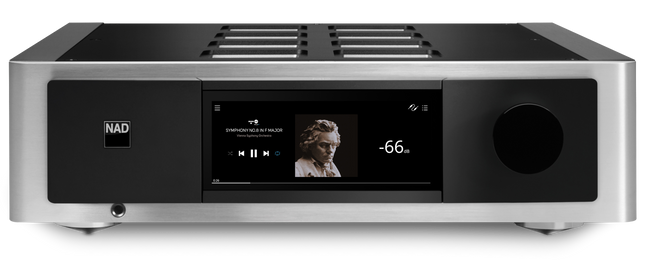Technical Performance
The M8xi delivers 550 + 550wpc into 8 ohms. It is extremely stable and very linear. The distortion is low too; lower than 0.005% in the audible frequency range of 20 Hz to 20 kHz. The M8xi has remarkable linearity and consistency. lt is unconditionally stable and will drive any loudspeaker in existence easily with ample power reserve.
Our Approach to Technical Measurements
In our view an amplifier should be completely neutral. lt is ‚a straight wire with gain‘. Easy to say but hard and complex to do. We want to stress that we do not believe that the technical performance is an end in itself. lt is a method of validating the total amplifier system concept. The aim of our circuit/PCB designs is to have low feedback and achieve complete neutrality, transparency, and great technical performance. The proof that we are on the right track is the technical performance. We think that technical performance cannot be summed up by the distortion at 1 kHz. Our view is that an amplifier has to be able to satisfy a wide range of technical requirements before it can be neutral.
Linearity
Almost all loudspeakers have complex impedance and loading curves. An amplifier must be able to maintain its voltage virtually, regardless of loading. If an amplifier cannot maintain its voltage across the spectrum, then the ultimate frequency response and distortion will be nonlinear. This is not neutrality.
Distortion
The overwhelming majority of amplifier manufacturers only talk about distortion at 1 kHz. We believe that this is only a fraction of the story. From our perspective, an amplifier must have very low distortion from 20 Hz- 20 kHz and beyond. We believe that an amplifier‘s high-frequency performance proves the total performance of the circuit and PCB layout. The M8xi distortion hardly changes from 10 kHz to 50 kHz. An outstanding achievement and validation of the circuit design and PCB layout.
Noise Ratio
Amplifiers should be quiet. If they are not, low-level detail is irretrievably lost. Also, the dynamic range is seriously compromised. Dynamic range is not just how much power an amplifier will produce, it is also how quiet it can be. Dynamic range is the total from the quietest to the loudest. The M8xi excels in this respect.
Precision Volume Control
The M8xi has a precision volume control. This ensures perfect tracking right down to very low levels which is unattainable with standard potentiometers. This outstanding precision is achieved by laser-trimmed substrate resistors.
Sound Quality
The M8xi is effortless, fluid, and dynamic. lt doesn‘t sound ‚loud‘. lt just sounds right. The dynamics are handled with no drama or fuss. They come and they go. There is no distortion; just pure undiluted music. lt sounds like a superb small Class A amplifier but with limitless headroom. Perfection!















